
HMS Upholder (P37) was a Royal Navy U-class submarine built by Vickers-Armstrong at Barrow-in-Furness. She was laid down on 30 October 1939, launched on 8 July 1940 by Mrs. Doris Thompson, wife of a director of the builders. The submarine was commissioned on 31 October 1940. She was one of four U-class submarines which had two external torpedo tubes at the bows in addition to the 4 internal ones fitted to all boats. They were excluded from the others because they interfered with depth-keeping at periscope depth.
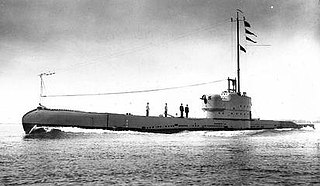
HMS Parthian was the lead boat of the six Royal Navy Parthian-class submarines, all launched in 1929. The submarine was sunk in 1943 during the Second World War. The submarine was nicknamed Peanut, from the identity letters PN painted on the fin.
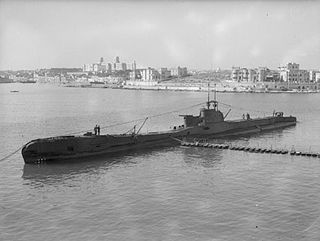
HMS Taku was a British T class submarine built by Cammell Laird, Birkenhead. She was laid down on 18 November 1937 and was commissioned on 3 October 1940.

The second HMS Talisman (N78), and the first to enter service under the name, was a T-class submarine of the Royal Navy. She was laid down by Cammell Laird & Co Limited, Birkenhead and launched on 29 January 1940.

HMSOlympus was an Odin-class submarine, a class originally designed for the Royal Australian Navy to cope with long distance patrolling in Pacific waters. Olympus was built to the same design for the Royal Navy. She served from 1931 to 1939 on the China Station and 1939-1940 out of Colombo. In 1940 she went to the Mediterranean. She was sunk by a mine off Malta in May 1942 killing 89 crew. 9 survivors: Herbert Rawlings,

HMS Unrivalled (P45) was a U-class submarine built for the Royal Navy during World War II. The boat has been the only ship of the Royal Navy to ever bear the name Unrivalled. Completed in 1942, the boat spent most of the war in the Mediterranean. She sank a number of small merchant ships and naval auxiliaries, but major success eluded her during the war. Too small and slow for the post-war environment, Unrivalled was scrapped in 1946.
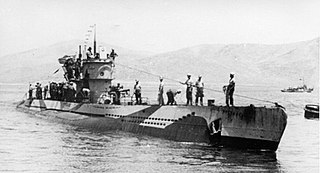
German submarine U-81 was a Type VIIC U-boat of the navy (Kriegsmarine) of Nazi Germany during World War II, famous for sinking the aircraft carrier HMS Ark Royal.
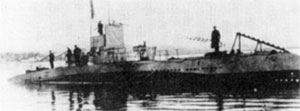
SM UB-42 was a Type UB II submarine or U-boat for the German Imperial Navy during World War I. UB-42 operated in the Mediterranean and the Black Seas during the war. She was broken up at Malta in 1920.
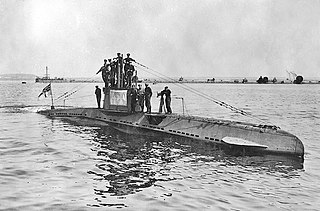
SM UB-14 was a German Type UB I submarine or U-boat in the German Imperial Navy during World War I. The submarine was also known by the Austro-Hungarian Navy designation of SM U-26.
German submarine U-652 was a Type VIIC U-boat of Nazi Germany's Kriegsmarine during World War II. The submarine was laid down on 5 February 1940 at the Howaldtswerke yard at Hamburg, launched on 7 February 1941, and commissioned on 3 April 1941 under the command of Oberleutnant zur See Georg-Werner Fraatz.

The German Type IXA submarine was a sub-class of the German Type IX submarine built for Nazi Germany's Kriegsmarine between 1937 and 1938. These U-boats were designed between 1935 and 1936 and were intended to be fairly large ocean-going submarines. The inspiration for the Type IXA submarine came from the German Type IA submarine, which had a similar diving depth and identical submerged horsepower.

HMS Pandora was a British Parthian-class submarine commissioned in 1930 and lost in 1942 during the Second World War. This class was the first to be fitted with Mark VIII torpedoes. On 4 July 1940 she torpedoed and sank the French aviso Rigault de Genouilly off the Algerian coast. In an extension of the Lend-Lease program, Pandora, along with three other British and French submarines, was overhauled at Portsmouth Naval Shipyard in the United States. She was sunk on 1 April 1942 by Junkers Ju 87 aircraft from Sturzkampfgeschwader 3 at the Valletta dockyard, Malta.
HMS Khartoum was a K-class destroyer of the Royal Navy, named after the capital of Sudan, Khartoum.

Albatros was a submarine chaser of the Regia Marina built in the 1930s which served during World War II. Later she was reclassified as a torpedo boat, most likely purely for administrative purposes.

HMS Regulus (N88) was a Rainbow-class submarine built for the Royal Navy during the 1930s.
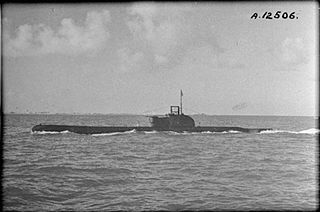
HMS Proteus was a Parthian-class submarine designed and built by Vickers Shipbuilding and Engineering in Barrow-in-Furness for the Royal Navy. She was laid down on 18 July 1928, launched on 22 August 1929 and completed on 17 June 1930. Like other submarines in her class she served on the China Station before the war. In the Second World War, mainly based at Alexandria in the Mediterranean, Proteus sank 15 enemy vessels and damaged several others during her service.

HMS Rainbow was a Rainbow-class submarine built for the Royal Navy during the 1930s.
German submarine U-409 was a Type VIIC U-boat of Nazi Germany's Kriegsmarine in World War II. She was laid down on 26 October 1940 by Danziger Werft, Danzig as yard number 110, launched on 23 September 1941 and commissioned on 21 January 1942 under Oberleutnant zur See Hanns-Ferdinand Massmann.

HMS Pakenham (G06) was a P-class destroyer of the British Royal Navy built and operated during World War II. Commissioned in early 1942, she took part in the invasion of Madagascar, and several Malta Convoys, before being disabled in a battle with Italian torpedo boats in April 1943 and scuttled.

















